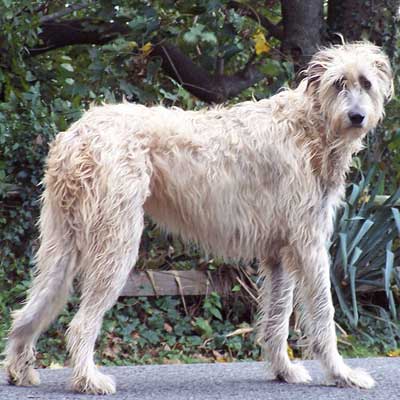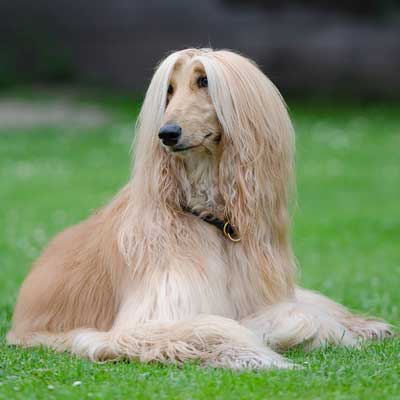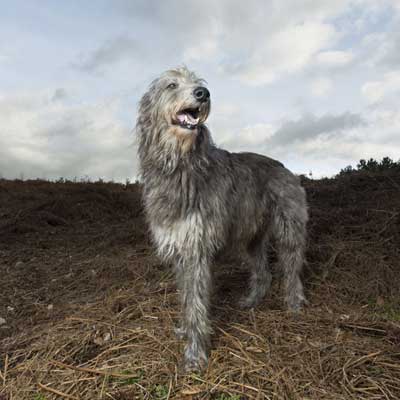Irish Wolfhound
Huge all around: for his character, for the size, for the courage
We know the continental Celts kept a greyhound probably descended from the greyhound first depicted in Egyptian paintings.Like their continental cousins, the Irish Celts were interested in breeding large hounds. These large Irish hounds could have had smooth or rough coats, but in later times, the rough coat predominated possibly because of the Irish climate.The first written account of these dogs was by a Roman Consul 391 A.D. but they were already established in Ireland in the first century A.D. when Setanta changed his name to Cu-Chulainn (the hound of Culann). Mention is made of the Uisneach (1st century) taking 150 hounds with them in their flight to Scotland.Irish hounds undoubtedly formed the basis of the Scottish Deerhound. Pairs of Irish hounds were prized as gifts by the Royal houses of Europe, Scandinavia and elsewhere from the Middle ages to the 17th century. They were sent to England, Spain, France, Sweden, Denmark, Persia, India and Poland.In the15th century each county in Ireland was required to keep 24 wolfdogs to protect farmers' flocks from the ravages of wolves. The Cromwellian prohibition (1652) on the export of Wolfhounds helped preserve their number for a time but the gradual disappearance of the wolf and continued demand abroad reduced their numbers almost to the point of extinction by the end of the 17th century.The revival of interest in the breed accompanied the growth of Irish nationalism in the late 19th century. The Irish Wolfhound became a living symbol of Irish culture and of the Celtic past. At this time, one determined enthusiast, Capt. G A Graham, set about obtaining some of the few remaining hounds of the Wolfhound type that could still be found in Ireland, and with the use of Deerhound blood and the occasional outcross of Borzoi and Great Dane, he eventually achieved a type of dog that bred true in every generation.The results were ultimately accepted as a legitimate revival of the breed. The Irish Kennel Club scheduled a class for Irish Wolfhounds at their show in April 1879, and a club was formed in 1885.The Irish Wolfhound now enjoys once again something of the reputation that it had in the Middle Ages. Wolfhounds are now owned and bred in fairly large numbers outside of Ireland.
-
Head
Long and level, carried high; the frontal bones of the forehead very slightly raised and very little indentation between the eyes -
Head - skull region
Skull: Not too broad -
Head - facial region
Muzzle : Long and moderately pointed.
Teeth: Scissor bite ideal, level acceptable
Eyes: Dark
Ears: Small, rose ears (Greyhound like in carriage) -
Neck
Rather long, very strong and muscular, well arched, without
dewlap or loose skin about the throat. -
Body
Long, well ribbed up.
Back: Rather long than short.
Loins: Slightly arched
Croup: Great breadth across hips
Chest: Very deep, moderately broad, breast wide.
Ribs: Well sprung
Belly: Well drawn up. -
Tail
Long and slightly curved, of moderate thickness, and well
covered with hair. -
Forequarters
Shoulders: Muscular, giving breadth of chest, set sloping.
Elbows: Well under, neither turned inwards nor outwards.
Forearm: Muscular, heavily boned, quite straight -
Hindquarters
Thighs: Long and muscular
Stifle : Nicely bent
Second thigh: Well muscled, long and strong
Hocks: Well let down and turning neither in nor out -
Feet
Moderately large and round, neither turned inward nor outwards. Toes, well arched and closed. Nails, very strong and curved -
Gait / Movement
Movements easy and active. -
Coat - hair
Rough and hard on body, legs and head; especially wiry.
Hair over eyes and beard especially wiry. -
Coat - colour
The recognised colours are grey, brindle, red, black, pure white, fawn or any colour that appears in the Deerhound. -
Size and weight
Desired height : averaging 32 inches (81cm) to 34 inches (86cm)
in dogs.
Minimum height : Dogs 31 inches (79 cm).
Minimum weight : Dogs 120 pounds (54.5kg).
Minimum height : Bitches 28 inches (71 cm).
Minimum weight : Bitches 90 pounds (40.5 kg). -
Faults
Any departure from the foregoing points should be considered a fault and the seriousness with which the fault should be regarded should be in exact proportion to its degree and its effect upon the health and welfare of the dog.
• Too light or too heavy a head.
• Too highly arched frontal bone.
• Crooked forelegs; weak pasterns.
• Weak hindquarters and a general want of muscle.
• Too short in body.
• Back sunken or hollow or quite straight.
• Large ears and hanging flat to the face.
• Twisted feet.
• Spreading toes.
• Short neck; full dewlap.
• Chest too narrow or too broad.
• Tail excessively curled.
• Nose of any colour other than black.
• Lips of any colour other than black.
• Very light eyes. Pink or liver coloured eyelids. -
Disqualifying faults
• Aggressive or overly shy dogs.
• Any dog clearly showing physical of behavioural abnormalities.
N.B.:
• Male animals should have two apparently normal testicles fully descended into the scrotum.
• Only functionally and clinically healthy dogs, with breed
typical conformation should be used for breeding.






